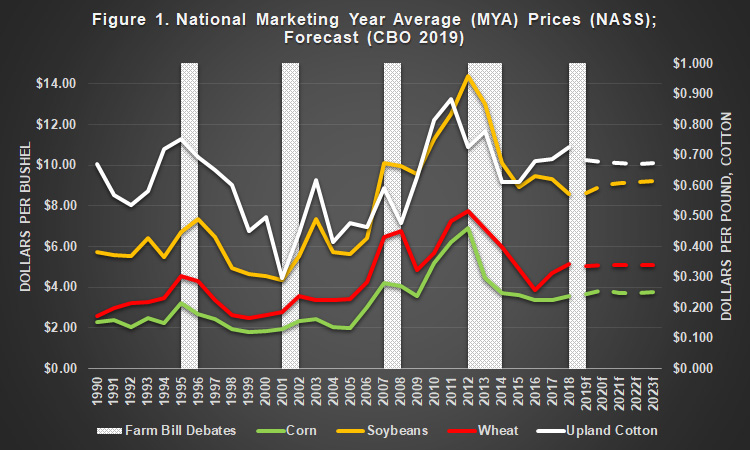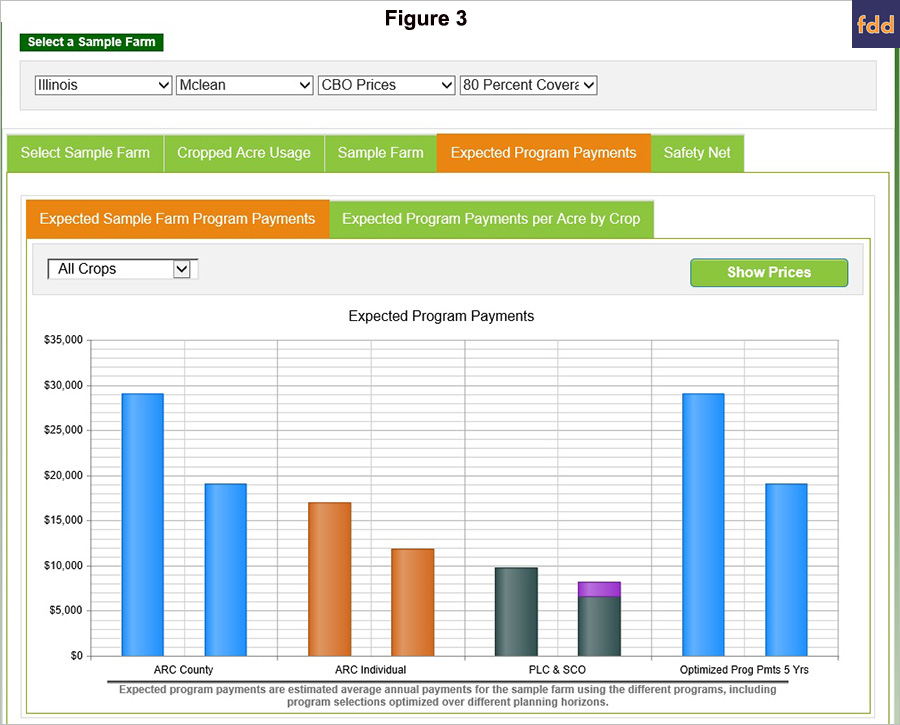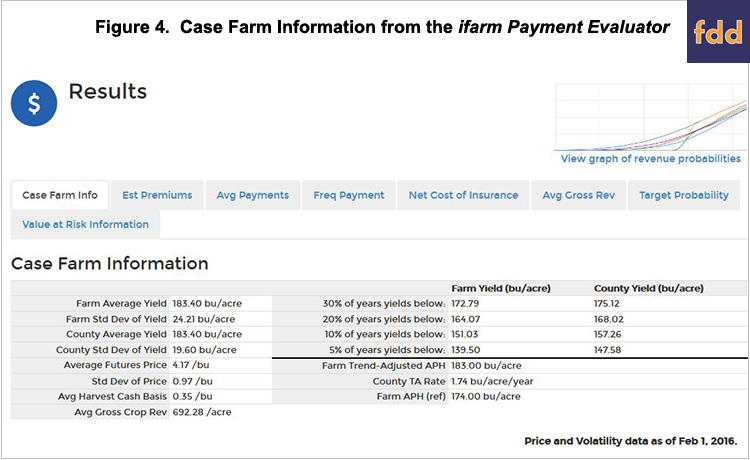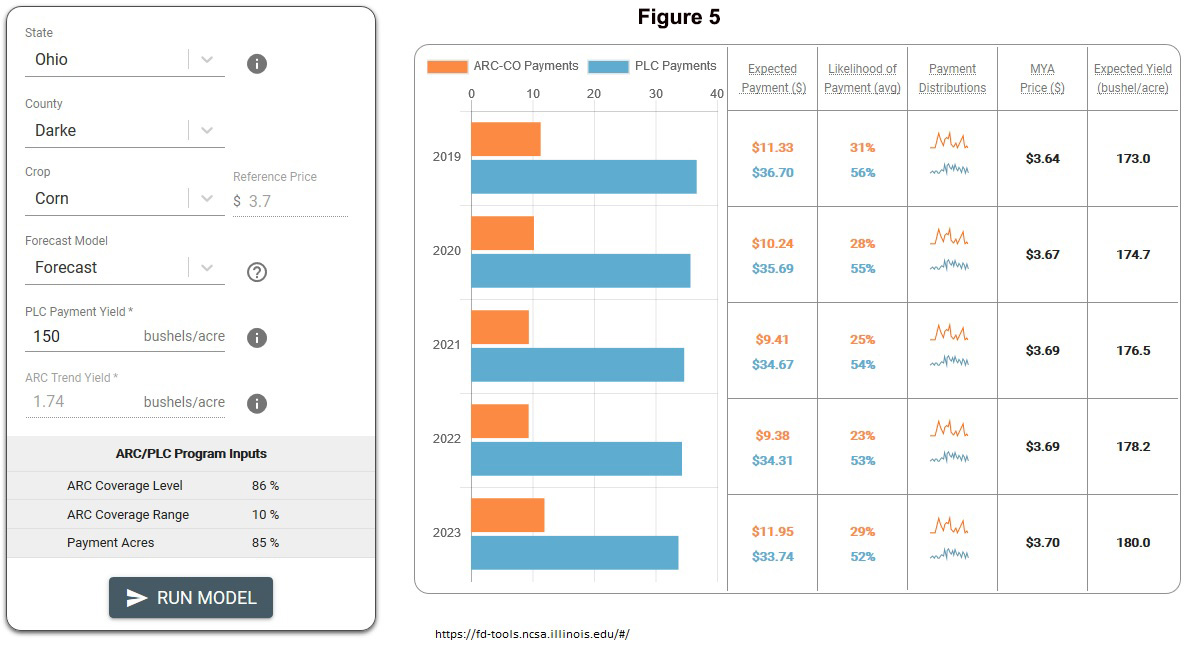Farm Policy Perspectives: 20th Anniversary of the farmdoc Project
This is the fourth in a series of articles celebrating the 20th anniversary of farmdoc. A list of all nine articles in the series and authors can be found at the end of this article.
In 1999, farm policy was transitioning into the modern era of decoupled support systems and an emphasis on crop insurance. As part of this 20th Anniversary commemoration series, this article reviews the farm policy developments over those years and the contributions of the farmdoc project.
Background
During the mid-1990s, commodity prices briefly spiked. Figure 1 illustrates Marketing Year Average (MYA) prices for the years 1990 to 2018 as reported by NASS, as well as Congressional Budget Office (CBO) May 2019 forecasts through 2023 (dashed line). Figure 1 also indicates the farm bill debates during this era. In 1999, the farmdoc project was founded. The years prior were consequential for farm policy. In 1994, Republicans won a majority of the seats in the House of Representatives for the first time in 40 years and Congress enacted the most consequential changes to farm policy in history in 1996. The Federal Agricultural Improvement and Reform Act of 1996 (FAIR) revised farm payment programs by decoupling payments from prices and planting decisions. It eliminated the target price and deficiency payment system created in 1973 and replaced it with Agricultural Market Transition Assistance (AMTA) payments. AMTA provided seven years of fixed contract payments on fixed contract (base) acres, using a percentage per crop of a total amount of funding per fiscal year; total funding decreased year-over-year through 2002.

A financial crisis in Asia starting in 1997 damaged export markets and prices, severely tarnishing the decoupled AMTA payment system. Beginning in 1998, Congress increased and then doubled AMTA payments to offset the impact of low prices through annual ad hoc appropriations legislation. This was the farm economic and policy situation under which the farmdoc project started.
The farm policies designed to respond counter-cyclically to prices, yields or revenues have undergone a slow evolution. In 2000, Congress reformed the federal crop insurance program, codifying revenue-based protection and substantially increasing premium subsides. The 2002 Farm Bill returned price-based payments in the form of the Counter-Cyclical Payments (CCP) program, in addition to continuing fixed annual (direct) payments; both programs remained decoupled from planting decisions. In 2005 and 2007, Congress created and then increased the Renewable Fuels Standard (RFS) bringing about further changes to the farm economy which, in turn, produced changes in farm policy. The impact on prices can be seen clearly after 2005, beginning with corn; an impact that was soon felt in farm policy.
The 2008 Farm Bill introduced a revenue-based option for farmers in the Title I commodities payment programs. Known as the Average Crop Revenue Election (ACRE), it provided farmers with an option to the fixed-price based CCP that included moving average prices and statewide yields as a method for providing better assistance to farmers, particularly when costs increased faster than production efficiency but adjusting if productivity increased faster than costs (Zulauf et al., 2008). Under partisan budget pressures and high crop prices during the Great Recession, the 2014 Farm Bill eliminated direct payments, assistance which had been in place since the 1996 Farm Bill created AMTA. In place of this annual payment, the 2014 Farm Bill offered farmers a five-year choice between a fixed price program, Price Loss Coverage (PLC), or a revenue-based program, Agriculture Risk Coverage (ARC) at either the county or individual farm levels; the farmdoc project led efforts to help inform farmers about this decision for their crops and farms (farmdoc daily, February 20, 2014; February 13, 2014). The 2018 Farm Bill continued the PLC/ARC program election for farmers with minor revisions and updates (farmdoc daily, December 12, 2018).
Adding perspective to the farm economic and policy background during the last 20 years, Figure 2 illustrates a comparison of the cash income from all farm payments to the cash income of all crop receipts, as reported by USDA’s Economic Research Service (ERS). Total payments are represented as a percentage of the income from crops; similar to Figure 1, the farm bill debates are highlighted. Figure 2 presents a snapshot of the interplay between farm economics and policy, with increases in the relative size of payments during times of economic stress and decreases in better times.

Discussion
Fast forward 20 years and the farm economic situation is once again caught in a struggle. First, a return to relatively lower prices since the peak during the 2012 drought, driven mostly by strong yields. Second, the impact on prices from a trade conflict initiated by President Trump and focused on China with significant damage to the growing export markets there, especially for soybeans. The impact of the trade conflict began with the 2018 marketing year but expected to continue in the 2019 marketing year (see, farmdoc daily, October 11, 2018).
Farm assistance programs are generally designed to be counter-cyclical in nature, responding with payments when prices, yields or revenue have fallen below pre-determined levels; lower prices likely to reduce revenues and income from crops, partially offset by program payments. For 20 years, the farmdoc project has informed farmers about the policies designed to assist with risk management and provide assistance during down cycles. It has evolved to include farmdoc daily articles such as those cited herein and additional efforts to help farmers navigate the economic cycles and the policies designed to help.
Recent additions to the farmdoc project are the variety of tools for helping farmers, businesses and policymakers better understand farm economic issues and policies; readily-accessible and easy-to-use examples of translating and demonstrating research. Many examples can be found on the Farm Analysis Solution Tools (FAST) section of the farmdoc project (https://farmdoc.illinois.edu/fast#tools); a few specific examples will be discussed further.
For the 2014 Farm Bill, the farmdoc project led a consortium of universities that received farm bill funding to develop a web-based decision tool developed in partnership with Watts & Associates; the tool known as the Agriculture Policy Analysis System (APAS) was supported by the Farm Bill Toolbox (farmdoc daily, January 15, 2015; September 30, 2014; July 10, 2014). The image below is from APAS tool run for McLean County, Illinois, in 2014. Subsequent research developed an understanding the value of these tools to farmers and landowners (farmdoc daily, December 8, 2017).

In 2016, the farmdoc project released an online calculator for crop insurance that was developed in partnership with the National Center for Supercomputing Applications (NCSA) at the University of Illinois (farmdoc daily, February 2, 2016). The image below as included in the release article as an initial run of the tool for a case farm and the most recent article on crop insurance using the tool was in March ahead of the closing date for purchasing coverage (farmdoc daily, March 1, 2019). The tool is available for use on the farmdoc project website: https://farmdoc.illinois.edu/crop-insurance.

In 2017, the farmdoc project introduced the Gardner Agriculture Policy Program to coordinate and prioritize policy-related research, analysis and articles (farmdoc daily, January 27, 2017). This work included articles for the Gardner Policy Series (https://farmdoc.illinois.edu/policy) and continued efforts to develop tools, such as the Gardner Farm Income and Policy Simulator which provides case farm simulations of financial analysis (farmdoc daily, March 6, 2018). The image below is from a recent article using the simulator (farmdoc daily, July 23, 2019).

Recently, the Gardner program, in partnership with NCSA and a cooperative agreement with USDA’s Office of the Chief Economist, released a new tool that estimates payments for ARC and PLC under the 2018 Farm Bill (farmdoc daily, August 20, 2019). The image below is from a run of the tool and it is available on the farmdoc website: https://fd-tools.ncsa.illinois.edu/.

Conclusion
From articles to tools, the farmdoc project continues to provide timely, relevant and usable information to farmers, businesses and policymakers. With the flexibility and adaptability that the internet offers, the farmdoc project can continue to adjust and adapt with changing times, policies and issues. The project, led by the Gardner program, will continue focusing analysis on the traditional categories for farm economics; the programs designed to assist farmers with the risks and challenges confronting them. As the list of risks and challenges for agriculture expands, however, the project’s focus will expand as well. Building on existing efforts, expansion begins with conservation policy—especially soil erosion and water issues such as nutrient loss reductions—as well as trade, and necessarily will encompass climate change and food policy.
References
Coppess, J., G. Schnitkey, N. Paulson and C. Zulauf. “Introducing the Gardner-farmdoc Payment Calculator.” farmdoc daily (9):154, Department of Agricultural and Consumer Economics, University of Illinois at Urbana-Champaign, August 20, 2019.
Coppess, J., G. Schnitkey, C. Zulauf, N. Paulson, B. Gramig and K. Swanson. “The Agriculture Improvement Act of 2018: Initial Review.” farmdoc daily (8):227, Department of Agricultural and Consumer Economics, University of Illinois at Urbana-Champaign, December 12, 2018.
Coppess, J., G. Schnitkey, N. Paulson and K. Baylis. “Introducing the Gardner Agriculture Policy Program.” farmdoc daily (7):15, Department of Agricultural and Consumer Economics, University of Illinois at Urbana-Champaign, January 27, 2017.
Coppess, J., G. Schnitkey, N. Paulson and C. Zulauf. “An Update on the Farm Bill Toolbox and Farm Bill Decisions.” farmdoc daily (5):8, Department of Agricultural and Consumer Economics, University of Illinois at Urbana-Champaign, January 15, 2015.
Coppess, J., N. Paulson and G. Schnitkey. “Introducing the Farm Bill Toolbox.” farmdoc daily (4):128, Department of Agricultural and Consumer Economics, University of Illinois at Urbana-Champaign, July 10, 2014.
Coppess, J. and N. Paulson. “Agriculture Risk Coverage and Price Loss Coverage in the 2014 Farm Bill.” farmdoc daily (4):32, Department of Agricultural and Consumer Economics, University of Illinois at Urbana-Champaign, February 20, 2014.
Coppess, J., N. Paulson, G. Schnitkey and C. Zulauf. “2014 Farm Bill Informational Efforts on farmdoc.” Department of Agricultural and Consumer Economics, University of Illinois at Urbana-Champaign, February 13, 2014.
Ellison, B., N. Paulson and J. Coppess. “The Value of Decision Tools to Farmers and Landowners.” farmdoc daily (7):226, Department of Agricultural and Consumer Economics, University of Illinois at Urbana-Champaign, December 8, 2017.
Swanson, K. and G. Schnitkey. “MFP Impact on 2019 through 2023 Incomes and Financial Positions.” farmdoc daily (9):134, Department of Agricultural and Consumer Economics, University of Illinois at Urbana-Champaign, July 23, 2019.
Swanson, K., G. Schnitkey and J. Coppess. “Reviewing Prices and Market Facilitation Payments.” farmdoc daily (8):188, Department of Agricultural and Consumer Economics, University of Illinois at Urbana-Champaign, October 11, 2018.
Swanson, K., G. Schnitkey, J. Coppess and N. Paulson. “Introducing the Gardner Farm Income and Policy Simulator.” farmdoc daily (8):39, Department of Agricultural and Consumer Economics, University of Illinois at Urbana-Champaign, March 6, 2018.
Schnitkey, G., B. Sherrick and S. Irwin. “Release of iFarm Premium Calculator and iFarm Payment Evaluator.” farmdoc daily (6):21, Department of Agricultural and Consumer Economics, University of Illinois at Urbana-Champaign, February 2, 2016.
Sherrick, B. and G. Schnitkey. “Crop Insurance Decisions for 2019.” farmdoc daily (9):37, Department of Agricultural and Consumer Economics, University of Illinois at Urbana-Champaign, March 1, 2019.
Zulauf, C.R., M.R. Dicks and J.D. Vitale. “ACRE (Average Crop Revenue Election) Farm Program: Provisions, Policy Background, and Farm Decision Analysis.” Choices (3rd Quarter 2008), available, http://www.choicesmagazine.org/magazine/article.php?article=33.
farmdoc daily 20th Anniversary Celebration Series
Irwin, S. “farmdoc at 20: How Did We Get Here and What Have We Learned?” farmdoc daily (9):163, Department of Agricultural and Consumer Economics, University of Illinois at Urbana-Champaign, September 3, 2019.
Hubbs, T. “Grain Price Outlook: farmdoc Twentieth Anniversary.” farmdoc daily (9):164, Department of Agricultural and Consumer Economics, University of Illinois at Urbana-Champaign, September 4, 2019.
Sherrick, B. and G. Schnitkey. “farmdoc and farmdoc daily Crop Insurance Contributions – 20 years and Counting.” farmdoc daily (9):165, Department of Agricultural and Consumer Economics, University of Illinois at Urbana-Champaign, September 5, 2019.
Coppess, J., C. Zulauf, N. Paulson and G. Schnitkey. “Farm Policy Perspectives: 20th Anniversary of the farmdoc Project.” farmdoc daily (9):166, Department of Agricultural and Consumer Economics, University of Illinois at Urbana-Champaign, September 6, 2019.
Schnitkey, G., D. Lattz, P. Ellinger, B. Sherrick and R. Batts. “Farm Management in farmdoc.” farmdoc daily (9):167, Department of Agricultural and Consumer Economics, University of Illinois at Urbana-Champaign, September 9, 2019.
Irwin, S. and D. Good. “Biofuels Markets and Policy: 20th Anniversary of the farmdoc Project.” farmdoc daily (9):168, Department of Agricultural and Consumer Economics, University of Illinois at Urbana-Champaign, September 10, 2019.
Baylis, K. and J. Coppess. “Farmdoc 20 Year Retrospective on Agricultural Trade (In Chart Form).” farmdoc daily (9):169, Department of Agricultural and Consumer Economics, University of Illinois at Urbana-Champaign, September 11, 2019.
Endres, A., D. Uchtmann and G. Hoff. “Law and Taxation: A Retrospective of 20 Years.” farmdoc daily (9):170, Department of Agricultural and Consumer Economics, University of Illinois at Urbana-Champaign, September 12, 2019.
Paulson, N. and B. Sherrick. “farmdoc and farmdoc daily: Farm Real Estate Markets – 20 Years and Growing.” farmdoc daily (9):171, Department of Agricultural and Consumer Economics, University of Illinois at Urbana-Champaign, September 13, 2019.
Disclaimer: We request all readers, electronic media and others follow our citation guidelines when re-posting articles from farmdoc daily. Guidelines are available here. The farmdoc daily website falls under University of Illinois copyright and intellectual property rights. For a detailed statement, please see the University of Illinois Copyright Information and Policies here.







